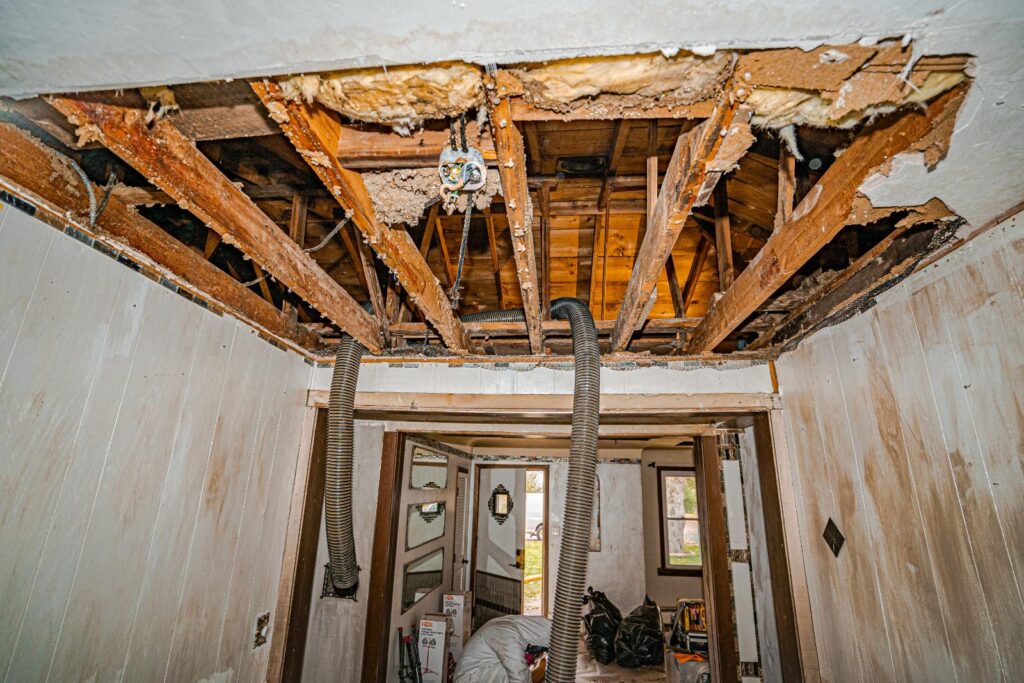
Contents
When water invades your space, it’s vital to act quickly with water extraction to minimize damage. Start by evaluating the situation to pinpoint the source and extent. Gather your tools, like a wet/dry vacuum and mops, to begin the extraction process. Ventilation is important for drying, but there are other steps you need to take into account to prevent mold. Discover how to effectively tackle the aftermath and regain control of your environment.
Key Takeaways
- Identify the water source and assess damage to understand the extent of the problem before starting any DIY efforts.
- Gather essential tools like wet/dry vacuums, mops, and fans to effectively remove and dry out water.
- Use a wet/dry vacuum to extract standing water, followed by mopping up residual moisture with towels.
- Ensure proper ventilation by opening windows and using fans to promote airflow for quicker drying.
- Act swiftly within 24 to 48 hours to prevent mold growth by cleaning, disinfecting, and dehumidifying the area.
Assessing the Damage: First Steps After a Water Incident
When you discover water damage in your home, the first step is to assess the situation quickly and thoroughly.
Start by identifying the water source; it could be a leaky pipe, a flooded basement, or an overflowing sink. Once you’ve pinpointed where the water’s coming from, you can begin your damage assessment.
Check all affected areas, including walls, floors, and ceilings, for signs of moisture or warping. Use your sense of touch to feel for dampness, and look for discoloration or mold growth.
Don’t forget to inspect furniture and belongings, as they might be at risk too. Document your findings with photos and notes—this’ll help you later when you need to discuss repairs or insurance claims.
Essential Tools for Effective Water Extraction
Having the right tools at your disposal is essential for effective water extraction. You don’t want to face a water incident unprepared.
With the right extraction equipment, you can reclaim your space and restore your peace of mind. Here are three must-have tools to take into account:
- Water Pumps: These are your frontline warriors. Whether you need to remove standing water or drain flooded areas, a quality water pump will do the job efficiently.
- Wet/Dry Vacuums: Perfect for sucking up smaller amounts of water, wet/dry vacuums are versatile and can tackle both liquids and debris.
- Squeegees and Mops: Often overlooked, these tools help you manage residual moisture and make sure your floors dry thoroughly.
Investing in these tools not only equips you for the current crisis but also prepares you for any future water woes.
You’ll feel empowered knowing you can tackle any situation head-on!
Step-by-Step Guide to DIY Water Removal
To tackle water removal effectively, follow this step-by-step guide that will help you reclaim your space.
First, conduct a damage assessment to identify the source and extent of water intrusion. This will direct your next steps.
Next, gather your essential tools: a wet/dry vacuum, mops, towels, and fans for air circulation.
Begin your water extraction by using the wet/dry vacuum to remove standing water. For stubborn areas, mop up excess moisture with towels.
Once you’ve extracted most of the water, guarantee proper ventilation by opening windows and using fans to accelerate drying.
Check for hidden moisture in walls and floors, as any lingering dampness can lead to further issues.
Finally, monitor the area over the following days to guarantee it’s completely dry.
Preventing Mold Growth After Water Damage
After you’ve tackled the initial water removal, it’s vital to act quickly to prevent mold growth, which can develop within 24 to 48 hours in damp conditions.
Here’s how you can guarantee effective mold prevention and humidity control:
- Ventilate the Area: Open windows and doors to increase airflow. Use fans to help circulate air and speed up drying.
- Dehumidify: Invest in a dehumidifier to keep humidity levels below 60%. This is fundamental in preventing mold spores from taking hold.
- Clean and Disinfect: Use a mixture of water and detergent, or a specialized mold cleaner, to scrub surfaces thoroughly.
Don’t forget to check hidden areas like behind walls and under carpets.
When to Call in the Professionals
While you may feel equipped to handle minor water damage on your own, certain situations clearly warrant professional intervention.
If you notice extensive damage, such as warped walls or flooring, it’s time to call in professional services. They’ve the tools and expertise to assess the situation accurately and prevent further issues.
Another red flag is persistent mold growth, which can pose serious health risks. If you’ve tried DIY methods and mold keeps coming back, professionals can effectively eradicate it and restore your space safely.
Additionally, if the water damage stems from a plumbing issue, like a burst pipe, don’t hesitate to reach out for help.
Professionals can fix the root cause while ensuring the area is properly dried and treated.
To Sum Up
By tackling your water woes head-on, you not only reclaim your space but also discover an unexpected resilience within yourself. Coincidentally, as you dry out your home, you’re also drying up worries and stress. With the right tools and a proactive approach, you can prevent mold and future mishaps. Remember, every step you take not only restores your environment but also empowers you to handle whatever life throws your way. Stay prepared, and you’ll always find a dry solution.
Recent Posts
10 DIY Tips for Emergency Water Extraction
Most people underestimate the urgency of addressing water damage immediately after it occurs. Quick action
Essential DIY Water Extraction Tips for Homeowners
When water damage strikes, it’s vital to act quickly and safely. You need to assess
3 Best DIY Water Extraction Tips for Homeowners
When water damage strikes your home, quick action, effective methods, and proper water extraction for
